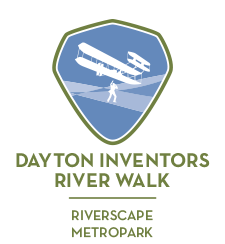RiverScape MetroPark
Dayton Inventors River Walk
Visit seven invention stations that celebrate Dayton inventions, sometimes in surprising ways
 The Dayton Inventors River Walk at RiverScape MetroPark celebrates Dayton’s history of invention, against a backdrop of sweeping views of the Great Miami River. Taking a casual walk down the park’s esplanade will bring you to seven over-sized sculptures, called Invention Stations, and more than 150 brick tiles commemorating innovations dreamed up right here in the Miami Valley that have forever changed our world. The Invention Stations are whimsical, interactive public art pieces that serve to keep things interesting in between activities such as ice skating in the winter or renting bikes in the summer for downtown denizens out for a day in the great urban outdoors. Make sure to take time to examine the brick tiles throughout the Dayton Inventors River Walk — you’ll be amazed!
The Dayton Inventors River Walk at RiverScape MetroPark celebrates Dayton’s history of invention, against a backdrop of sweeping views of the Great Miami River. Taking a casual walk down the park’s esplanade will bring you to seven over-sized sculptures, called Invention Stations, and more than 150 brick tiles commemorating innovations dreamed up right here in the Miami Valley that have forever changed our world. The Invention Stations are whimsical, interactive public art pieces that serve to keep things interesting in between activities such as ice skating in the winter or renting bikes in the summer for downtown denizens out for a day in the great urban outdoors. Make sure to take time to examine the brick tiles throughout the Dayton Inventors River Walk — you’ll be amazed!
The River Walk begins at the northeast corner of Main Street and Monument Avenue with an 8-inch by 8-inch brick medallion in the pavement. This medallion claims Dayton to be the Innovation Capital of the World, by virtue of the fact that Dayton, throughout much of its history, has had more inventions per capita than any city in the United States. This acclaim was first achieved, not in the wondrous years of the Wright Brothers and Charles F. Kettering, but earlier, in the 1800s. So it wasn’t these famous sons who spawned a climate of innovation in Dayton as many assume; but perhaps it was the climate of innovation already existing in Dayton that spawned our famous sons and some of the world’s most revered inventors.
Dayton has scores more stories of innovation to tell. The brick medallions continue down Monument Avenue and Patterson Boulevard leading the way along the walk and telling the stories of other Dayton inventors. These stories include that of Joe Desch, who cracked the German “Enigma” code and put the Allies on course for victory in World War II, as well as the origins of cellophane, digital watches, recycled newsprint, Freon and “Star Wars” technology.
Information taken from The Grand Eccentrics, Mark Bernstein, 1996.
Invention Stations
Automobile Self Starter
Charles F. Kettering led the automotive world in innovation for decades and was a prolific inventor. Vincent G. Apple holds the record for the greatest number of patents in Dayton at 350. Prior to Kettering’s invention, drivers frequently broke their arms crank-starting their cars. Kettering’s automatic starter ended the pain of starting cars with the turn of a key introduced on the 1912 Cadillac. A pavilion commemorates the starter at the west end of RiverScape. The pavilion also includes some of Kettering’s clever quotes, for which he was famous. One story that reveals Kettering’s ingenuity as well as his sense of humor involved painting new cars. The process took more than a month and that was too long. Kettering developed a paint that would dry in a few minutes, but he still had to convince General Motors it would work. He took a skeptic to lunch one day. When they emerged from the restaurant the man couldn’t find his car. “Isn’t that your car?” Kettering said. “My car isn’t that color,” the man replied. Kettering raised his eyebrows. “It is now.”
Hydraulic Jump Fountain
Arthur P. Morgan came to Dayton after the 1913 flood to design a flood control system to protect the entire Miami Valley. One element of this system was a dry dam—a dam that held water only during a flood and released the water at a rate that the downstream riverbed could carry. The problem was that the speed of the water through the dam made it powerful and destructive. To solve that problem, Morgan went with Col. Edward Deeds to Deeds’ farm in Moraine, where they built models in his swimming pool. They developed the hydraulic jump, which sends water through a series of baffles and steps, and then finally into a low wall that forces the water back onto itself, dissipating its own energy. This process of turning water onto itself is the hydraulic jump. From there, the water flows downstream calmly. This technology is still used in hydrological engineering throughout the world. RiverScape demonstrates the hydraulic jump in the fountain that falls down the levee from Festival Plaza to the harbor.
Search Engine
When searching on the Internet for “MetroParks and RiverScape or Van Cleve Park not Deeds Point,” you’ll not only find some great websites, but you’ll be employing the Boolean search method that was developed in downtown Dayton. This method of searching, which uses “and,” “or” and “not” to define parameters, was so successful that it led to LexisNexis becoming a leading source of information, perhaps the information source leader in the world. The aspect of this search engine that made it more successful than others is that it was “scaleable,” meaning that it worked well no matter how many parameters were applied or how much information was searched. The search engine Invention Station at RiverScape will allow you to do some searching of your own — come see what you can find.
Pop-Top Can
Ermal Fraze, owner of Dayton Reliable Tool and Manufacturing Company, invented the familiar pop-top aluminum can. The legend goes that, in the late 1950s, Fraze was at a family picnic and wanted a beer, but had forgotten the can opener. He was forced to use the bumper of his car to open the beer. In his frustration, Fraze vowed to develop an easy-opening can. The first shipments of the pop top can went to the Iron City brewery, and the public response was enthusiastic. The Pop Top Invention Station is one of the stations that will surprise you — we won’t say how. Visit RiverScape to find out.
Cash Register
John Patterson, founder of NCR, did not invent the cash register, as many people assume. Patterson was an entrepreneur who bought the patent from the two Dayton brothers who had invented the “Incorruptible Cashier.” James Ritty, a saloonkeeper, came up with the idea after losing so much money to thieving clerks. On an ocean voyage, Ritty visited the engine room, where he saw a machine that counted the rotations of the ship’s propeller. He partnered with his brother John, a machinist, to develop the first cash register. Patterson first bought two registers; then five years later, in 1884, he bought the company that held Ritty’s patents, sight unseen. The company was in tremendous debt and had a horrible reputation. Within four years, however, Patterson had turned the young company around so completely that it was unable to keep up with orders. That company was National Cash Register.
Ice Cube Trays
So many of Dayton’s inventions have become common in our daily lives. Vincent G. Apple brought electricity to rural homes; Dr. William H. Charch invented cellophane; E.R. Churchwell, working in the Biltmore Hotel, developed the first collapsible baby crib. The ice cube tray is another such invention. Arthur Frei, working at Frigidaire, developed 23 patents on the ice cube tray. One of his most significant developments was the quick release lever on top of the tray that dislodged the cubes. Prior to that, the metal tray had to be soaked in hot water to free the ice.


